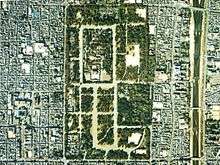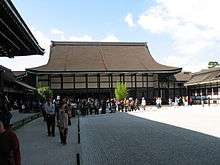Kyoto Imperial Palace

The Kyoto Imperial Palace (京都御所 Kyoto-gosho) is the former ruling palace of the Emperor of Japan. The emperors have resided at the Tokyo Imperial Palace since 1869 (Meiji Restoration); the preservation of the Kyoto Imperial Palace was ordered in 1877. Today the grounds are open to the public, and the Imperial Household Agency hosts public tours of the buildings several times a day.
The Kyoto Imperial Palace is the latest of the imperial palaces built at or near its site in the north-eastern part of the old capital of Heiankyo after the abandonment of the larger original Heian Palace (大内裏 Dai-dairi) that was located to the west of the current palace during the Heian Period. The Palace lost much of its function at the time of the Meiji Restoration, when the capital functions were moved to Tokyo in 1869. However, the Taisho and Showa Emperors still had their enthronement ceremonies at the palace.
Layout

The palace is situated in the Kyoto-gyoen (京都御苑), a large rectangular enclosure 1,300 metres (4,300 ft) north to south and 700 metres (2,300 ft) east to west which also contains the Sento Imperial Palace gardens. The estate dates from the early Edo period when the residence of high court nobles were grouped close together with the palace and the area walled. When the capital was moved to Tokyo, the residences of the court nobles were demolished and most of Kyoto Gyoen is now a park open to the public.
The Imperial Palace has been officially located in this area since the final abandonment of the Daidairi in late 12th century. However, it was already much earlier that the de facto residence of the emperors was often not in the Inner Palace (内裏 dairi) of the original Heian period palace, but in one of the temporary residences (里内裏 sato-dairi) in this part of the city and often provided to the emperor by powerful noble families. The present palace is a direct successor—after iterations of rebuilding—to one of these sato-dairi palaces, the Tsuchimikado Dono (土御門殿 Tsuchimikado-dono) of the Fujiwara clan. The palace, like many of the oldest and most important buildings in Japan, was destroyed by fire and rebuilt many times over the course of its history. It has been destroyed and rebuilt eight times, six of them during the 250-year-long peace of the Edo period. The version currently standing was completed in 1855, with an attempt at reproducing the Heian period architecture and style of the original dairi of the Heian Palace.
The grounds include a number of buildings, along with the imperial residence, or dairi (内裏). The neighbouring building to the north is the sento (仙洞), or residence of the retired emperor, and beyond that, across Imadegawa Avenue, sits Doshisha University. The Imperial Household Agency maintains the building and the grounds and also runs public tours.[1]
Structures
The main buildings are, among other halls, the Shishin-den (紫宸殿, Hall for State Ceremonies), Seiryo-den (清涼殿, Emperor's Habitual Residence), Ko-gosho (小御所, Court Room), o-gakumonjo (御学問所, Imperial Study or Library[2]), and a number of residences for the empress, high-ranking aristocrats and government officials.
Okurumayose
Dignitaries with special permission for official visits used to enter the palace through the Okurumayose entrance.
Shodaibunoma
The Shodaibunoma building was used as a waiting room for dignitaries on their official visits to the palace. They were ushered into three different anterooms according to their ranks.
Shinmikurumayose
The Shinmikurumayose structure was built as a new carriage entrance on the occasion of the enthronment ceremony of Emperor Taisho in 1915.
Gates

For state ceremonies, the dignitaries would enter through the Kenreimon (建礼門), which has a cypress-wood roof, and is supported by four unpainted wooden pillars. This gate would have been used on the rare occasions of the emperor welcoming a foreign diplomat or dignitary, as well as for many other important state ceremonies. Passing through the Kenreimon, the inner gate Jomeimon would appear, which is painted in vermilion and roofed in tile. This leads to the Shishin-den, which is the Hall for State Ceremonies. The Gekkamon is a smaller gate on the west side of the main courtyard.
Another gate in the outer courtyard is the Kenshunmon, which has a similar architectural style to the Kenreimon. Located next to the Kenshunmon is a square where the traditional ball game Kemari is played.
-
Jomeimon
-
Kenshunmon
Shunko-den
The Shunko-den was constructed to house the sacred mirror on the occasion of the enthronement ceremony of Emperor Taisho in 1915. The roof is modern in that it is made out of copper and not wooden shingles.
Shishin-den
The Shishinden is the most important ceremonial building within the palace grounds. The enthronement ceremonies of Emperor Taisho and Emperor Showa took place here. The hall is 33 by 23 metres (108 by 75 ft) in size, and features a traditional architectural style, with a gabled and hipped roof. On either side of its main stairway were planted trees which would become very famous and sacred, a cherry (sakura) on the eastern, left side, and a tachibana orange tree on the right to the west. The garden of white gravel played an important role in the ceremony.
The centre of the Shishin-den is surrounded by a hisashi (庇), a long, thin hallway which surrounded the main wing of an aristocrat's home, in traditional Heian architecture. Within this is a wide open space, crossed by boarded-over sections, leading to the central throne room.
-
Enthronement of Emperor Taisho in 1915
-
Sakon no Sakura tree
-
Ukon no Tachibana tree
Takamikura

The Takamikura (高御座) is the imperial throne. It has been used on the occasion of the enthronement ceremonies commencing in 707 in the reign of Emperor Genmei. The present throne was modelled on the original design, constructed in 1913 two before the enthronement of Emperor Taisho. The actual throne is a chair in black lacquer, placed under an octagonal canopy resting on a three-tiered dais painted with black lacquer with balustradres of vermilion. On both side of the throne are two little tables, where the imperial regalia such as the sword and the great seal would be placed. On top of the canopy is a statue of a large phoenix called ho-o. Surrounding the canopy are eight small phoenixes, jewels and mirrors. Hanging from the canopy are metal ornaments and curtains.
The sliding door that hid the monarch from view is called kenjo no shoji (賢聖障子), and had an image of 32 Chinese saints painted upon it, which became one of the primary models for all of Heian period painting.
Michodai
The Michodai (御帳台) is the August Seat of the Empress. The current throne was constructed in 1913. Its colour and shape are the same as the Takamikura, but is slightly smaller and more simple in comparison. The canopy is decorated with a statue of the mythical bird rancho.
The imperial throne is always placed in the centre of the main hall, the michodai to the right of it. Both thrones are kept away from public view through screens called misu.
Seiryo-den

The Seiryo-den sits to the west of the Shishin-den, facing east. It, too, has a hipped and gabled roof, and is primarily cypress wood. Originally a place where the Emperor would conduct his own personal affairs, the Seiryo-den was later used for various gatherings and meetings as well. In the centre is an area where the Emperor would rest, and on the east side of the hall, an area of two tatami was set aside for dignitaries and aristocrats to sit. Here was where the Emperor could conduct formal affairs. On the north side of the hall was an enclosed area where the Emperor would sleep at night; later, Emperors began to use the official residence. The west side was set aside for the Emperor's breakfasts, and also contained the lavatories, while the south side was used by the keeper of the Imperial Archives. This area contained paintings by the masters of the Tosa school, and just outside, various rare bamboos were planted.
The original structure was built as the emperor's residence at the end of the 8th century and was used until the 11th century. The seiryoden was rebuilt in this location in 1790 CE, on a smaller scale than the original building but preserving the original structure.
Kogosho
The Kogosho is a place where the emperor received bannermen under the direct control of the Tokugawa shogun (buke). It was also used for some rituals. This distinctive building shows a blend of architectural elements of shinden zukuri and shoin zukuri styles.
The Kogosho Conference was held here on the night of December 9, 1867, the declaration of the restoration of imperial rule (osei fukko). The structure burnt down in 1954 and was reconstructed in 1958.
Ogakumonjo
The study hall Ogakumonjo was for reading rites, a monthly poetry recital and also a place the emperor received nobles. It is a shoin zukuri style building with an irimoya hiwadabuki roof.
Otsunegoten
The Otsunegoten was used as the emperor's residence until the capital was transferred to Tokyo in 1869. It is the largest structure of the palace with fifteen rooms. Facing it is the Gonaeitei garden.
Osuzumisho
The Osuzumisho is the summer residence for the emperor.
Koshun
The Koshun is a study hall that was used by Emperor Komei, who reigned from 1846 to 1866.
Omima
The Omima was used for unofficial ceremonies such as the Star Festival and the Bon festival.
The Palace's Suzaku-mon Gate is walking distance from JR Nijo Station.
-

Sarugatsuji
-

Oike-niwa (御池庭) garden and pond
References
- This article is almost entirely a faithful translation of the Kyoto Gosho article from the Japanese Wikipedia.
- ↑ "Visiting Procedures for Foreigners -- Kyoto Imperial Palace". Retrieved 2007-09-12.
- ↑ "ごがくもんじょ【御学問所】の意味 - 国語辞書 - goo辞書". goo辞書.
External links
| Wikimedia Commons has media related to Kyoto Imperial Palace. |
- Imperial Household Agency | Kyoto Imperial Palace
- Photos of Kyoto Imperial Palace
- Satellite View of the Kyoto Imperial Palace at Wikimapia
Coordinates: 35°01′31″N 135°45′44″E / 35.02528°N 135.76222°E
| ||||||||||||
